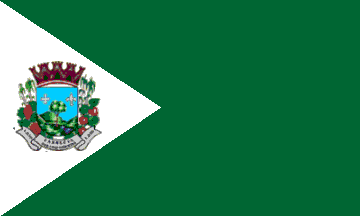 image
by André Pires Godinho
image
by André Pires Godinho
Last modified: 2013-07-19 by ian macdonald
Keywords: sao paulo | cabreúva | triangle (white) |
Links: FOTW homepage |
search |
disclaimer and copyright |
write us |
mirrors
Source:
Official municipal website.
André Pires Godinho, 15 February 2003
Green flag, a white equilateral triangle extending from the hoist, bearing the municipal arms.
The municipality of Cabreúva (41,643 inhabitants in 2010; 25,981 ha), part of the Jundiaí Urban Area, is located 80 km of São Paulo. Cabreúva was founded in the early 18th century by a member of the Martins e Ramos family, originating from Itu, who settled on the right bank of river Tietê. Martins grew sugarcane and produced a famous brandy that yielded the nickname of "Terra da Pinga" to the place. About one century later, farmers offered a piece of land to build a chapel dedicated to St. Benedict, which had to be rebuilt from scratch in 1856 by another family.Cabreúva is named for the cabreúva tree (Myrocarpus frondosus Fr. Allem, family Fabaceae), known in Tupi-Guarani as "kaburé-iwa", "owl
tree". The tree produces timber wood and an aromatic balsam used in
traditional medicine. The trunk of such a tree was used as a makeshift
bridge to cross the Fathers' River, today Cabreúva River, on which the
village was built.
http://www.cabreuva.sp.gov.br/conheca_cabreuva/historia.html -
Municipal website
Article 2 of the Municipal Constitution, adopted on 4 April 1990 and
last amended on 31 January 2007, prescribes the symbols of Cabreúva,
without further description, as "the coat of arms, the flag and the
anthem, representative of its culture and history".
http://www.cabreuva.sp.gov.br/pdf/Leis/Lei_Organica.pdf - Municipal
Constitution
Photos of the flag:
http://www.cabreuva.sp.gov.br/noticias/2011/129_Hasteamento_da_Bandeira.html
http://www.cabreuva.sp.gov.br/noticias/2010/060_Hasteamento_da_Bandeira.html
http://www.cabreuva.sp.gov.br/noticias/2009/026_Hasteamento_da_Bandeira.html
http://www.cabreuva.sp.gov.br/noticias/2009/196_Reuniao_da_Avon.html
http://www.cabreuva.sp.gov.br/noticias/2009/194_Prefeito_anuncia_nova_secretaria.html
http://www.cabreuva.sp.gov.br/noticias/2010/048_27_anos_de_tombamento_serra_do_japi.html
http://assembleiadedeusregionalcabreuva.webnode.com.br/album/jubileu%20de%20ouro%202011%201º%20e%202º%20dia/entrada-da-bandeira-jpg
http://www.saopaulo.sp.gov.br/spnoticias/lenoticia.php?id=5564&c=6#1
The coat of arms of Cabreúva is "An Iberic shield, azure (blue) three mountains above a river planted on the right bank with a cabreúva tree surrounded by a cross patty and a fleur-de-lis. The shield surmounted by an eight-towered brick mural crown ports sable (black). The shield supported dexter by a branch of grapevine with two bunches of grapes and sinister by a strawberry plant with three berries, and in the background by four sugarcanes. Below the shield a scroll inscribed with '1.830 - CABREÚVA / SUB LEGE LIBERTAS - 1.859' all sable."
The Iberic shield, used in Portugal at the time of discovery of
Brazil, evokes the early colonizers.
Azure represents the sky covering the horizon. The cross recalls the
deep Christian faith. The fleur-de-lis is the symbol of the town's
patron saint, Our Lady of Piety.
The tree recalls the makeshift bridge arranged with the trunk of a
cabreúva, the town's namesake.
The river represents the link of the legendary river Tietê with the
municipality.
The mountains, represented in green for the richness of the flora and
the exuberance of the geography, stand for Serra Japi, Serra Guaxqtuba
and Serra Taguá.
The mural crown is a symbol of municipal emancipation. The open ports
are a symbol of hospitality. The bricks recall the traditional
industry in the municipality.
The grapevine, the strawberry and the sugarcanes highlight the
fertility of the soil and the importance of agriculture.
The years "1830" and "1859" stand for the establishment of the
district and of the municipality, respectively.
http://www.cabreuva.sp.gov.br/conheca_cabreuva/hino_bandeira.html -
Municipal website
Ivan Sache, 31 December 2012